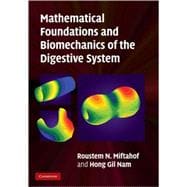
Note: Supplemental materials are not guaranteed with Rental or Used book purchases.
Purchase Benefits
Looking to rent a book? Rent Mathematical Foundations and Biomechanics of the Digestive System [ISBN: 9780521116626] for the semester, quarter, and short term or search our site for other textbooks by Roustem N. Miftahof , Hong Gil Nam. Renting a textbook can save you up to 90% from the cost of buying.
| Preface | p. xi |
| Notation | p. xv |
| Introduction | p. 1 |
| Exercises | p. 4 |
| The geometry of the surface | p. 6 |
| Intrinsic geometry | p. 6 |
| Extrinsic geometry | p. 8 |
| The equations of Gauss and Codazzi | p. 13 |
| General curvilinear coordinates | p. 15 |
| Deformation of the surface | p. 18 |
| Equations of compatibility | p. 22 |
| Exercises | p. 26 |
| Parameterization of shells of complex geometry | p. 28 |
| Fictitious deformations | p. 28 |
| Parameterization of the equidistant surface | p. 31 |
| A single-function variant of the method of fictitious deformation | p. 33 |
| Parameterization of a complex surface in preferred coordinates | p. 37 |
| Parameterization of complex surfaces on a plane | p. 42 |
| Exercises | p. 46 |
| Nonlinear theory of thin shells | p. 47 |
| Deformation of the shell | p. 47 |
| Forces and moments | p. 50 |
| Equations of equilibrium | p. 55 |
| Exercises | p. 60 |
| The continuum model of the biological tissue | p. 61 |
| Structure of the tissue | p. 61 |
| Biocomposite as a mechanochemical continuum | p. 62 |
| The biological factor | p. 71 |
| Exercises | p. 74 |
| Boundary conditions | p. 76 |
| The geometry of the boundary | p. 76 |
| Stresses on the boundary | p. 78 |
| Static boundary conditions | p. 81 |
| Deformations of the edge | p. 84 |
| Gauss-Codazzi equations for the boundary | p. 87 |
| Exercises | p. 88 |
| Soft shells | p. 89 |
| Deformation of soft shell | p. 89 |
| Principal deformations | p. 95 |
| Membrane forces | p. 97 |
| Principal membrane forces | p. 100 |
| Corollaries of the fundamental assumptions | p. 101 |
| Nets | p. 105 |
| Equations of motion in general curvilinear coordinates | p. 106 |
| Governing equations in orthogonal Cartesian coordinates | p. 109 |
| Governing equations in cylindrical coordinates | p. 111 |
| Exercises | p. 113 |
| Biomechanics of the stomach | p. 115 |
| Anatomical and physiological background | p. 115 |
| Constitutive relations for the tissue | p. 119 |
| A one-dimensional model of gastric muscle | p. 130 |
| Myoelectrical activity | p. 132 |
| Decrease in external Ca2+ concentration | p. 133 |
| Effects of T- and L-type Ca2+-channel antagonists | p. 134 |
| Acetylcholme-induced myoelectrical responses | p. 135 |
| Effect of chloride-channel antagonist | p. 136 |
| Effect of selective K+-channel antagonist | p. 136 |
| The stomach as a soft biological shell | p. 137 |
| Inflation of the stomach | p. 140 |
| The electromechanical wave phenomenon | p. 142 |
| The chronaxiae of pacemaker discharges | p. 145 |
| Multiple pacemakers | p. 147 |
| Pharmacology of myoelectrical activity | p. 155 |
| Exercises | p. 155 |
| Biomechanics of the small intestine | p. 157 |
| Anatomical and physiological background | p. 157 |
| A one-dimensional model of intestinal muscle | p. 158 |
| Myoelectrical activity | p. 159 |
| Effects of non-selective Ca2+-channel agonists | p. 160 |
| Effects of Ca2+-activated K+-channel agonist | p. 160 |
| Response to a selective K+-channel agonist | p. 161 |
| Effect of selective K+-channel antagonist | p. 163 |
| Conjoint effect of changes in Ca2+ dynamics and extracellular K+ concentrations | p. 164 |
| The small intestine as a soft cylindrical shell | p. 165 |
| Pendular movements | p. 166 |
| Segmentation | p. 168 |
| Peristaltic movements | p. 173 |
| Self-sustained periodic activity | p. 173 |
| Effect of lidocaine | p. 177 |
| Exercises | p. 180 |
| Biomechanics of the large intestine | p. 182 |
| Anatomical and physiological background | p. 182 |
| The colon as a soft shell | p. 184 |
| Haustrai churning | p. 187 |
| Contractions of the teniae coli | p. 187 |
| Peristalsis and propulsive movements | p. 192 |
| Pharmacology of colonic motility | p. 192 |
| Effect of Lotronex | p. 192 |
| Effect of Zelnorm | p. 194 |
| Exercises | p. 194 |
| Biological applications of mathematical modeling | p. 196 |
| Biomechanics of hollow abdominal viscera | p. 196 |
| Future developments and applications | p. 201 |
| Exercises | p. 208 |
| References | p. 210 |
| Index | p. 217 |
| Table of Contents provided by Ingram. All Rights Reserved. |
The New copy of this book will include any supplemental materials advertised. Please check the title of the book to determine if it should include any access cards, study guides, lab manuals, CDs, etc.
The Used, Rental and eBook copies of this book are not guaranteed to include any supplemental materials. Typically, only the book itself is included. This is true even if the title states it includes any access cards, study guides, lab manuals, CDs, etc.